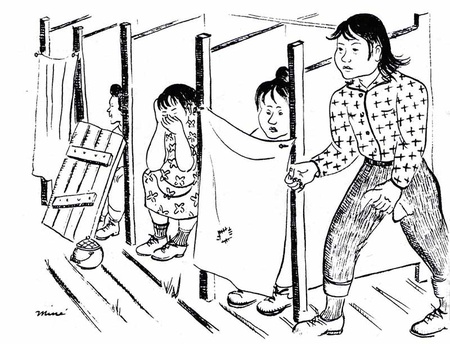Read Part 4 >>
History Recast as Art: Documentary and Fictional Accounts of Exile and Banishment
Those views were shaped in turn by artistic, literary, documentary and nonfiction accounts of the Japanese American war experience. Born Free and Equal was forgotten amid the post-war building boom as a curtain of silence descended upon this chapter of history. One early exception was artist Miné Okubo’s powerful book, Citizen 13660, published by Columbia University Press in 1946. Okubo included 206 of her own illustrations of life in the unlawful California “assembly” center Tanforan and the Topaz, Utah concentration camp, accompanied by rueful, sometimes humorous, descriptions that subtly and indirectly criticized the forced imprisonment. Through her words and powerful drawings, Okubo captured the bittersweet essence of the experience in a way that photographs could not do. Although her book created a stir when it came out, Okubo later acknowledged, “The war was forgotten during the fifties. People throughout the country were busy rebuilding their lives.”

Miné Okubo's description of this illustration from "Citizen 13660" noted the difficulty many women experienced adjusting to the open toilets: "They sought privacy by pinning up curtains and setting up boards." (Source: Gift of the Miné Okubo Estate, Japanese American National Museum [2007.62])
As the Sansei came of age in the late ’60s and early ’70s, their curiosity about the prison camps, which most had heard little about, led to a more critical discussion of the camp and the beginnings of the redress movement. In 1972 Richard and Maisie Conrat selected many of Dorothea Lange’s images for a book of photographs titled Executive Order 9066, to present what they considered a more truthful picture of the Japanese imprisonment than what had been previously disclosed. That same year Jeanne Wakatsuki Houston and her husband James D. Houston published a groundbreaking memoir, Farewell to Manzanar, an unvarnished and moving account of Wakatsuki Houston’s life from age 7 to 17, detailing her imprisonment at Manzanar and re-entry into civilian life.
Wakatsuki Houston’s memoir, especially of the initial days of the camp, is very different from the more established Manzanar that Adams described (“Everyone seemed constructively occupied, alert, and cheerful”). She described being “sick continually,” at first from the heavy doses of typhoid vaccination administered, then from the food. “…The packed sleeping quarters, the communal mess halls, the open toilets – all this was an open insult to that other, private self, a slap in the face you were powerless to challenge.”
A made-for-television movie based on Farewell to Manzanar aired in 1976, the same year Michi Weglyn’s nonfiction account, Years of Infamy: the Untold Story of America’s Concentration Camps, came out. In her book, Weglyn debunked the U.S. government’s assessment of the “military necessity” of the prison camps, and attributed its treatment of Japanese aliens and citizens to naked racism and economic exploitation. The American public’s disillusionment over the Vietnam War and the Watergate scandal added fuel to the campaign for restitution waged by activist Nisei and Sansei. Their efforts resulted in the passage of the Civil Liberties Act of 1988, which provided each surviving internee with an official apology and $20,000 in reparations. Media coverage of this historic event helped pique interest in director Alan Parker’s 1990 Hollywood movie about the mass roundup of Japanese, Come See the Paradise.
Since the first publication of documentary photographs of Manzanar, the attitude in the Japanese community toward its forced exile has metamorphosed from silent shame to recognition of injustice, then to militancy in calling for redress, and now, a desire to preserve inmates’ stories as cautionary tales to offer in the face of contemporary breaches of civil rights.
© 2011 Nancy Matsumoto






